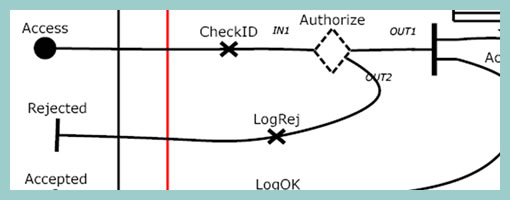Use Case Maps
February 19th, 2010
Speaking with Greg the other day I learned about Use Case Maps. This notation which has been initially the work of Raymond Buhr, has its roots in software engineering and perhaps could be an area to draw inspiration from. Use Case Maps intend to convey sequences of events by showing the paths of users over a backdrop of structured system representations. With these flexible scenario-like visualizations, software engineers ensure that the element of time is considered. As part of the notation, Use Case Maps have starting and stopping points and can also branch out. It seems like Daniel Amyot has contributed to this work as well and has published a decent Quick Tutorial with a reference guide at the end. In a nutshell, here is what Daniel writes about the philosophy of UCM:
The Use Case Map notation aims to link behavior and structure in an explicit and visual way. UCM paths are first-class architectural entities that describe causal relationships between responsibilities, which are bound to underlying organizational structures of abstract components. These paths represent scenarios that intend to bridge the gap between requirements (use cases) and detailed design.
Credits: Raymond A. Buhr & Daniel Amyot
























February 20th, 2010 at 2:54 am
Interesting!
What would be the advantage over UML diagrams?
February 28th, 2010 at 1:13 pm
Good question Rolf, but i think, Use Case Maps are good alternative to UML diagrams.
March 8th, 2010 at 6:28 pm
Use Case Maps are part of the User Requirements Notation standard (ITU-T Recommendation Z.151), together with the Goal-oriented Requirement Language. There are many differences with UML, but I think it is best to have a look for yourselves at http://www.usecasemaps.org/ (main site) http://www.usecasemaps.org/pub/ (virtual library), and http://jucmnav.softwareengineering.ca/jucmnav/ (jUCMNav tool, a free Eclipse plug-in)